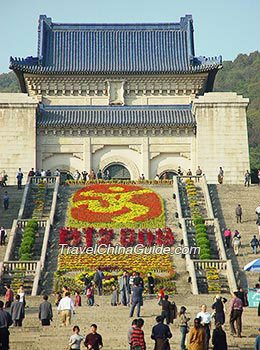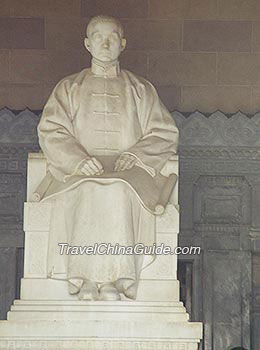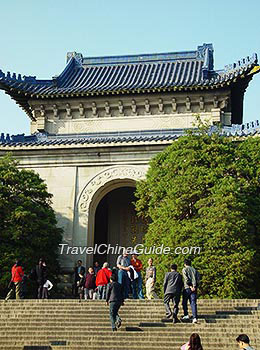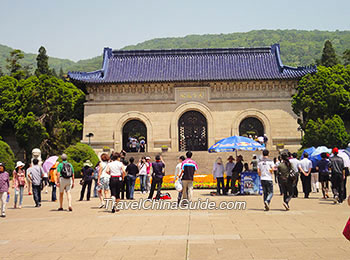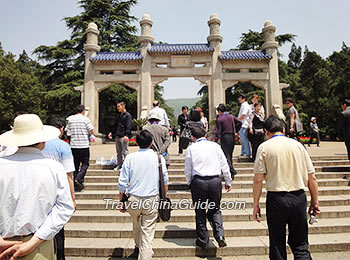Dr. Sun Yat-sen's Mausoleum
Dr. Sun Yat-sen (1866-1925) was a great forerunner of the Chinese democratic revolution and led by Dr. Sun the Chinese people brought down the corrupt rule of the Qing Dynasty (1644-1911) and ended 2,000 years of the feudal monarchy system, which led the people into a new age.
The majestic construction inside the Dr. Sun Yat-sen's Mausoleum was started in 1926 and completed in 1929. The whole scenic area represents an alarm bell as seen from the air, symbolizing the noble spirit and heroic efforts of Dr. Sun Yat-sen's devotion to the Chinese people, fight of oppression and wining the independence of the country. Facing south, the structures, along with the mountain ascends gradually along with the central axis line running from south to the north and is regarded as the most outstanding mausoleum in the country's modern architectural history.
|
|
|
Traveling along the marble road, firstly you will arrive at half-moon square in the south of the Dr. Sun Yat-sen's Mausoleum. It is understated and modest, while endowing grandeur to the Dr. Sun Yat-sen's Mausoleum. Then at the entrance stands the great marble Paifang (memorial archway) on which is written 'Bo Ai' meaning 'love'. Through Paifang there is a Passway of 480 meters (about 1,574 feet) long and 40 meters (about 131 feet) wide, on both sides of which stand orderly pine and cypresses trees. Continuing forward to the end of the Passway, there is the Frontispiece, standing some 16.5 meters (about 54 feet) high and 27 meters (about 88 feet) wide. The Frontispiece has three archways, each of which has a pair of symmetrical enchased copper gates. Four Chinese characters are inscribed on the lintel over the doorways written by Dr. Sun Yat-sen meaning 'the world is commonwealth', which fully explains the cause he struggled for during his life. Through the Frontispiece is a pavilion made of marble, in which a great stele, 9 meters (about 29 feet) high and 4 meters (about 13 feet) wide, was erected by Kuomintang in memory of Dr. Sun Yat-sen. On the stele there are carved just 24 Chinese characters and no epitaph as people think that there are no words capable of representing this giant of modern China.
|
|
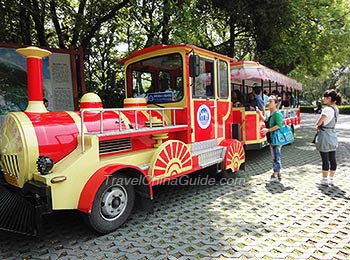 |
| The Sightseeing Train |
Around the Sacrificial Hall, there are two 12.6-meter-high (about 41 feet) Huabiao, ornamental columns like those in Tiananmen Square. Entering the Hall, a 4.6-meter-high (15 feet) stone statue of Dr. Sun Yat-sen sits in the center. He wears long gown with eyes facing forward, with an open book on his lap, demonstrating the wisdom of the great thinker. At the foot of the statue, there are six embossments exhibiting in vivid pictures Dr. Sun Yat-sen's glorious life and struggles in his revolution. The door of the tomb is in the center of the back wall.
The whole tomb is a hemispherical in shape, with the marble coffin of Dr. Sun Yat-sen set in the center of the chamber. His white marble statue rests atop the rectangle coffin, under which this historical giant forever sleeps.
Around the Dr. Sun Yat-sen's Mausoleum there are many memorial buildings such as the Zhengqi Pavilion, Open-air Music Hall, Waxwork Home of Democratic Revolution, the Sun Yat-sen Museum and so on.
How to get to Dr. Sun Yat-sen's Mausoleum
2. Take bus 34 to Zhongshanling Tingchechang.
Nanjing Bus / Metro Search
| Entrance Fee | Mausoleum is free, but visitors need to use their passports to book the tickets in advance. The reservation system of the official website and Wechat account is available from 7:00 to 22:00; and visitors can also book it on site through machines, which are available from 8:00 to 17:00. The free ticket covers Entrance to the Mausoleum, the Stele Pavilion, the Sacrificial Hall and the Burial Room. The Open-air Music Hall charges CNY 10. CNY 100 for a combo ticket covering the Open-air Music Hall, Xiaoling Mausoleum of Ming Dynasty, Linggu Temple, and Meiling Palace. Free for children under 1.4m (4.6 feet). | |
| Opening Time: | 08:30-17:00; Closed on Monday except on holidays and Nov. 12 & Mar. 12 (anniversary of Dr. Sun Yat-sen's birth and death); The Burial Room is also closed at weekends except on holidays. The Open-air Music Hall: Mar. - Nov.: 6:30 - 18:30; Dec. - Feb.: 7:00 - 17:30. | |
Tips:
Plum Blossom Hill
Nanjing Underwater World
Meiling Palace
Top 10 Things to Do in Nanjing
12 Best Places to Visit in Nanjing
